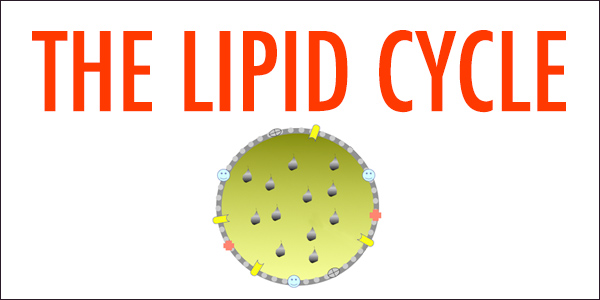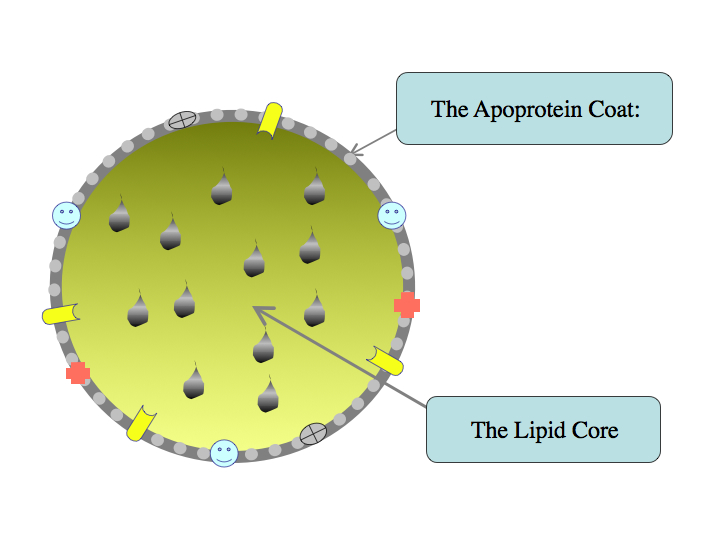

Do you guys like science? How about facts? Fact: Dr. Cate Shanahan is one smart woman. Fact: When Dr. Shanahan says she’s gonna write a blog post explaining the lipid cycle, she is a woman of her word and gives us the skinny on lipids. Fact: If you think you couldn’t love Dr. Shanahan any more than you already do, keep on reading. Go, science!!
————————————
The Lipid Cycle
When sitting down with patients to review cholesterol results, including their HDL and LDL numbers, I am often asked which is the good cholesterol and which is the bad. I explain to them that HDL and LDL are neither good nor bad, they simply do different things. In fact, HDL and LDL are not even “cholesterol” they are fat-carrying particles called lipoproteins and lipoproteins exist to nourish our cells. If that’s new information to you don’t feel bad. We’ve all been bamboozled by the companies who profit by keeping us in the dark about how all this works, so to help folks better understand lipoproteins and what their numbers really mean I came up with the concept of The Lipid Cycle.
The Lipid Cycle describes the process of digesting and distributing dietary fats. Lipoproteins are supposed to circulate through out body delivering fats, that’s their job. When our habits are unhealthy, dysfunctional lipoproteins can’t do their job. Dysfunctional lipoproteins, not HDL or LDL, are the problem. Although taking cholesterol pills will reduce most people’s total cholesterol, doing so does not help your lipoproteins function better and therefore carries few benefits for the majority of people.
What do I mean by dysfunctional lipoprotein? Let’s first take a good look at a functional lipoprotein and then go from there.
This is a lipoprotein.
A lipoprotein is a tiny blob of fat neatly wrapped in protein. See the blobs in the greenish area of the circle? That’s fat. Some of it came from your diet, and some came from fats your cells made. The fat is encased in a coat of protein (grey rim), called apoprotein. See all the symbols embedded in the rim? Those symbols symbolize the fact that there is chemical information encoded in the apoprotein that the help the body know this blob is a lipoprotein and not, for example, an invading bacterial cell that should be destroyed.
Lets take a closer look at the lipoprotein and how it works for us.
The fat in the lipoprotein contains 2 very important things:
- Fat soluble vitamins A, D, E, K, nutrients like phosopholipids and choline, and essential fats like omega-3.
- Fatty acids that the body can use for energy. (Any “extra” not needed for energy immediately will be stored in the fat under your skin.)
The apoprotein coat does 2 very important things:
•It serves as a kind of identification label so that the body knows what it is.
- It keeps the fat suspended in circulation.
Unhealthy habits like smoking, lack of sleep or exercise and eating poorly can interfere with both of the apoproteins’ functions listed above and that is how they lead to arterial diseases.
The first thing unhealthy habits do is damage the identification system so that and cells don’t recognize the lipoprotein anymore. Once rendered unrecognizable to cells, the lipoprotein can’t deliver fats to hungry cells. This is not that big of a deal, however, because it’s not like your cells with starve—after all there are plenty of other lipoproteins coming because we eat multiple times a day.
The second thing that unhealthy habits do is to destabilize the coat. The coat actually oxidizes (burns—more information on this in chapter 8 of our book Deep Nutrition), similar to how leather gets old and flakey and then can crack easily. This is serious because when the lipoprotein’s coat eventually cracks enough to leak, the contents escape and, sort of like junk falling off an overloaded truck on the highway, can lead to accidents. But unlike on a highway where the victims of the accident are drivers of other cars, in the artery the victim is the arterial wall itself, or the guardrail in this analogy. Although the body releases white blood cells to clean up these kinds of accidents, the cleanup process often further damages the arterial wall and contributes to formation of atherosclerotic plaque.
Over time, the plaque gets thicker and/or the arterial wall gets weaker, increasing your risk for heart attacks in 2 distinct ways.
- If a small piece of the thickened plaque breaks off and lodges downstream in the artery blocking flow, the heart attack is small and you usually survive—especially if you get to the hospital quickly.
- If the weakened arterial wall cracks, blood may leak out of the artery and form a clot in the artery, causing a massive and possibly fatal heart attack.
For anyone who wants to see how that works, or know why LDL (the supposed bad cholesterol) goes up and HDL (the supposed good cholesterol) goes down in many people with unhealthy habits as well as what your numbers should be, we explain all, including pictures, in Chapter 8 of Deep Nutrition.
————————————————–
Dr. Cate Shanahan bio:
Cate Shanahan MD specializes in weight loss, sports performance, and elimination of medication dependence using traditional foods.
As a Family Medicine physician practicing in Hawaii, she recognized the limitations of pharmaceutical intervention and created a dietary program based on the culinary traditions shared by all her healthiest, longest-lived patients. These elements, which she calls The Four Pillars of World Cuisine, became the basis of her first book.
In 2010, she spearheaded T.R.I.M. (Treatment to Reverse Inflammatory Metabolism), a 12- week program that uses food as medicine to treat patients with diabetes, overweight, cancer and other aspects of metabolic imbalance. She has discovered that the Four Pillar principle of dietary balance has filled in
gaps missing from many other popular diets and enabled patients to break past weight loss and performance plateaus as well as reverse intestinal, joint, and brain inflammation.
In 2012, Dr Cate began consulting with Los Angeles Lakers’ players including Steve Nash, Kobe Bryant, and Dwight Howard. Together with husband Luke Shanahan, the couple has partnered with leadership of the Los Angeles Lakers training staff to spearhead PRO Nutrition: Performance, Recovery, Orthogenesis. Dr. Cate has lectured across the country and the Pacific, featured in the documentary film Doctored, Consumers Digest, Better Homes and Gardens, the LA Times, Your Health Matters (WKXL), and numerous websites, online, and traditional media radio/TV shows including DrLoRadio, Underground Wellness, The Food Rightʼs Hour, and LivinLaVidaLowCarb with Jimmy Moore.
Dr. Cate has authored two books: Deep Nutrition, Why Your Genes Need Traditional Food and Food Rules, A Doctor’s Guide to Healthy Eating and she blogs regularly at DrCate.com


